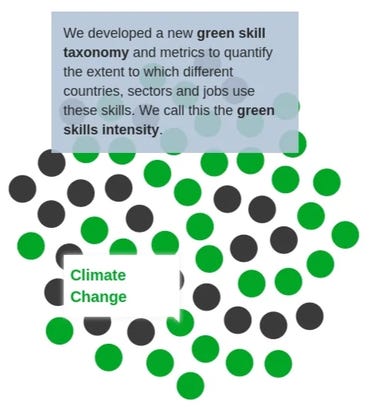[ad_1]

LinkedIn embarked on an analysis of green skills and green jobs based on data from its nearly 800 million members worldwide
The “Great Resignation” is making the headlines, but LinkedIn and the World Economic Forum argue it’s all part of the “Great Reshuffle” — a time when everyone is rethinking everything. The term first aired in 2021 and has been making the rounds since.
LinkedIn purports that the Great Reshuffle presents a unique opportunity to tackle humanity’s most urgent challenge: climate change. We have to enable the green transition and activate the jobs, companies and policies that power it, but there are a number of challenges associated with that.
That’s the introduction to LinkedIn’s recently published Global Green Skills Report 2022. As LinkedIn CEO Ryan Roslansky writes in the report, LinkedIn wants to do its part by leveraging its unique data and labour market expertise to highlight actionable insights that are crucial to delivering a successful green transition and avoiding potential pitfalls.
LinkedIn’s data are a valuable source of insights. However, there are also important blind spots in the report.
Green skills and green jobs
Achieving our collective global climate targets is a monumental task, and it is going to take a whole-of-economy effort to make it happen. That means we need a transformation in the skills and jobs people have if we’re going to get there, writes Roslansky.
Roslansky notes that there is some good news: LinkedIn is seeing a shift to green skills and jobs underway on its platform, which has nearly 800 million members worldwide. Green talent (LinkedIn members who have explicitly added green skills to their profile and/or are working in a green or greening job) in the workforce worldwide is rising. The share of green talent increased from 9.6% in 2015 to 13.3% in 2021 — a growth rate of 38.5%.
Another point Roslansky highlights are that millions of new jobs are expected to be created globally in the next decade, driven by new climate policies and commitments. For example, in the last five years, the number of Renewables & Environment jobs in the U.S. has increased by 237%, in stark contrast to the 19% increase for Oil & Gas jobs. At this pace, the Renewables & Environment sector will outnumber Oil & Gas in total jobs on LinkedIn by 2023.
But it’s more than jobs, Roslansky thinks — we need to zoom in on the skills that power these jobs. LinkedIn’s take is that real change will come through a skills-based approach to opportunity, emphasizing what it calls green skills: skills that enable the environmental sustainability of economic activities.
LinkedIn developed a new green skill taxonomy and metrics to quantify the extent to which different countries, sectors and jobs use these skills. This is called green skills intensity. Many green skills are on the rise and are among the fastest-growing skills in the economy, LinkedIn notes.
For example, Sustainable Fashion, Environmental Services and Sustainable Growth have all grown by over 60% over the past 5 years. However, LinkedIn’s findings show that most jobs requiring green skills are not traditional green jobs. LinkedIn looked at over 15,000 jobs and split them into four categories based on their green skill intensity.
Green jobs are those that cannot be performed without extensive knowledge of green skills. Greening jobs are those that can be performed without green skills but typically require some green skills. Greening potential jobs are ones that could be performed without green skills but typically require at least one green skill, and Non-green jobs are those that do not require green skills to be performed.
The big picture
LinkedIn’s first key finding is that not enough workers are being hired into green jobs. The hiring of green jobs in the global workforce is rising faster than any other category. But together, green and greening jobs still only accounted for 10% of hiring in 2021.
Trends vary across different regions and sectors, but the takeaway is the same, LinkedIn notes: at this pace, moving toward a green economy will require workers to upskill in green and enter green, greening, and greening potential jobs.
LinkedIn emphasizes that while more workers are transitioning into green and greening jobs than are leaving, the total number of workers moving into those jobs is still really low. Today, almost all green jobs are filled by those coming from other green jobs. Transitions into Green from Greening and Greening Potential show some promise but are still well below what is needed to contribute meaningfully to a greener economy.
Also: 2022 technology trend review, part one: Open source, cloud, blockchain
LinkedIn’s report distills four more trends shaping the green economy.
First, demand for green talent will soon outpace supply. In the past year, ~10% of job postings requiring skills have explicitly required at least one green skill — which is generally aligned with ~10% of the hires in the same period going to green or greening jobs. However, while job postings requiring green skills grew at 8% annually over the past five years, the share of green talent has grown at roughly 6% annually in the same period.
Second, the hiring of green talent is accelerating faster than overall hiring. In 2019, the hiring balance tipped towards green talent, as the green hiring rate accelerated ahead of the overall hiring rate in most economies around the world.
This means that green workers were hired at a higher rate than non-green workers globally. The COVID-19 pandemic has accelerated this trend, suggesting that green talent has been relatively more resilient to an economic downturn than non-green talent.
Third, there’s currently a good balance in the necessary green skills. Currently, there is a relatively good balance in the supply and demand of green skills. Half of the top 10 in-demand green skills match the most popular skills among the green workforce, including Sustainability, Renewable Energy, Environmental Awareness, Environment, Health and Safety (EHS), and Corporate Social Responsibility.
Fourth, the fastest-growing green skills are both mainstream and emerging. Some skills in high employer demand that show relatively lower prevalence in the workforce are Remediation, Recycling, OSHA, Climate and Solar Energy — but the last three listed are among the fastest-growing skills in 2016–2020.
Also: 2022 technology trend review, part two: AI and graphs
And several of the fastest-growing green skills across all sectors during the same time period were not necessarily in-demand skills but suggested the emergence of new trends, including Sustainable Fashion, Oil Spill Response and Sustainable Business Strategies, among others.
LinkedIn’s data are a great source to derive insights from. LinkedIn’s report is quite comprehensive, as it does not just offer data-driven insights but also dives into specific case studies, identifies trends blocking an equitable transition for workers and a sustainable transition for the planet, and lays out an action plan with recommendations for policymakers, business leaders and the global workforce.
Taxonomies are the duct tape of connected data – green ones, too
Despite LinkedIn’s value as a source of data and the effort that has gone into this, there are some blind spots as well. First off, the methodological grounding of the report is not entirely transparent.
It’s understandable that having access to LinkedIn’s data would be neither feasible nor practical for a number of reasons. The authors of the report have tried to do their job as all good analysts do — by diving into the data and distilling the most valuable insights for others to consume.
LinkedIn’s analysis is based on the concept of green skills, as this is what’s used to identify green talent and classify jobs as to their relevance for a green transition. However, this new green skill taxonomy that LinkedIn created is not shared with the public either. Again, we can understand the reasons. Taxonomy creation is hard work, and LinkedIn probably views this as its intellectual property.

Taxonomies are imperfect tools to organize data and knowledge, and green taxonomies are no different
As former Technical Lead for Taxonomies and Ontologies, AI Division at LinkedIn, Mike Dillinger notes that taxonomies are the duct tape of connected data. They seem simple, flexible, and familiar. They are widely used. And they seem to work across many use cases and many domains.
But when looked at in more detail, taxonomies turn out to be crude tools for knowledge organization that are very difficult to create, to scale, to adapt, to align, and to build on. They don’t work well for larger or more complex domains and use cases. Experienced talent and flexible tools for creating them are hard to find and to develop. Often taxonomies are built and then abandoned for other, more robust approaches to knowledge organization.
Perhaps more importantly, taxonomies, like any other knowledge organization approach, represent a subjective and imperfect way to look at the world. Case in point — the European Commission has recently published its own taxonomy of skills for the green transition in European Skills, Competences, Qualifications and Occupations (ESCO).
It includes 381 skills, 185 knowledge concepts and 5 transversal skills considered most relevant for a greener labour market. Examples of green skills as defined in ESCO include conducting energy audits, measuring the sustainability of tourism activities, and training staff on recycling programmes.
It’s possible that LinkedIn consulted ESCO in creating its own green skill taxonomy, but we’ll probably never know. Without visibility into LinkedIn’s taxonomy and data, it’s impossible to verify the validity of its analysis. Not to mention — all LinkedIn member skill assessment is done by members themselves, with everything this entails.
Are green skills driving sustainable change in the European automotive industry?
Another example of the fact that even data-driven analysis is often not as clear-cut as it seems is LinkedIn’s reference to how green skills are driving sustainable change in the European automotive industry. LinkedIn notes that the move to electric is reshaping the talent profile of the automotive industry, and the need for innovation to cut emissions has influenced a sustained technological change in the European automotive industry.
LinkedIn data shows that the share of green talent has been increasing by 11.3% annually for the past five years — exhibiting one of the highest growth rates in green talent among all manufacturing sectors. Some of the fastest-growing sustainable transportation skills in the region are related to electric vehicles and energy management, LinkedIn notes.
The skills LinkedIn refers to are Electric Vehicles, Energy Storage, Battery Management Systems, Lithium-ion Batteries, and Electric Cars, with Compounded Annual Growth (CAGR) rates between 51,2% and 27,6%.
First off, it’s not at all clear whether there is an overlap between those. Electrical Vehicles are clearly a superset of Electric Cars, for example. So does the 51.2% CAGR of the former include the 27.6% CAGR of the latter, or not? We just don’t know, so the picture that emerges out of this could be distorted.
But even more alarmingly – are we sure that these are actually green skills? It may sound counter-intuitive, but the extent to which electric cars are actually green is not entirely clear. That is according to an analysis done by Volvo, a European car manufacturer.
Volvo’s analysis showed that manufacturing an electric car generates 70% more emissions than its ICE equivalent. However, when the car’s lifetime is factored in, a breakeven is reached, and the EV’s total carbon footprint is less compared to that of the ICE vehicle’s. This is a nuanced analysis, and the outcome depends on a number of variables, such what is the vehicle’s end of life and how electricity is generated.
That’s not to say that we should disregard either LinkedIn’s analysis or the challenge of climate change entirely. But it goes to show that the devil is often in the details. We need transparency, attention to detail, and a holistic approach to derive insights.
[ad_2]
Source link





More Stories
NADA RV Values
Ideas For Eco-Friendly RV Camping
All About Auto Glass Repair